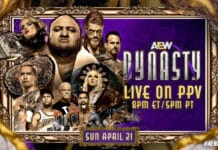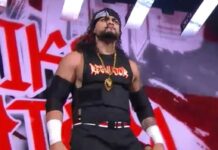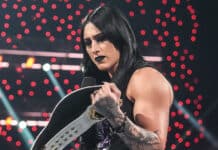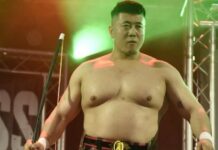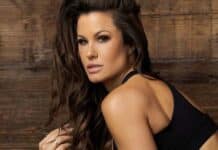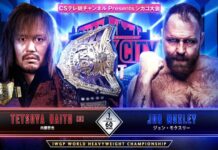While tonight is an NXT Takeover event, it also marks 22 years since the St. Valentine’s Day Massacre pay-per-view event in 1999. With the name as a spinoff of the infamous Chicago mob wars of the 1920s, the Attitude era broadcast had the benefit of the wave of momentum that went along with the surge in popularity of the time period. Something that I’ve noticed when re-watching these shows for these reviews is how that previously mentioned momentum can cover for some rather subpar segments. By nature, because it was such a boom period with some really thrilling television, the Monday Night Wars get remembered fondly, but it definitely wasn’t perfect. In fact, there are sometimes entire shows that doesn’t hold up in hindsight.
This event would fall somewhere in the middle on that spectrum, showcasing why the era was such a big time for the industry, and some of the ways the “Jerry Springer booking” had Vince Russo’s finger prints all over it.
The show opened with Goldust vs. The Blue Meanie, who dressed himself up as “Blue Dust” to mock his opponent. The match itself was more or less nothing, as it went a little more than two minutes with a portion of that spent with Meanie outside the ring attempting to stall. I’m not saying every match on pay-per-view has to be a 30-minute epic confrontation, but I’ve always found it puzzling why either too many matches were jammed onto a card so there wasn’t time for some of them to get more than a few minutes or a match was shoehorned onto the show just to get it a spot on pay-per-view. There are very few scenarios where a two-minute bout can get a feud or a performer over on pay-per-view. Speaking of Russo, he has talked about his work with the Goldust character in several interviews, but I’d almost say that the scripting of the persona in this era is one of the reasons Dustin Runnels had to leave for WCW to reinvent his career. Russo took the bizarre elements of Goldust and even The Meanie, and made them more of a lame comedy sketch than anything. Keep in mind, the original run of the Goldust character got over to the level it did because he was presented as a threat so there were layers to what the persona could be booked for in storylines. Meanie was just there to act like a fool, and the association with Runnels after this more or less typecast him until he left the company later in the year. As far as this pay-per-view, Goldust got the win, but this match isn’t actually a career highlight for either competitor. That said, both Goldust and Meanie are much better performers than they had the chance to show here, proof of that being that Dustin is still a stellar performer today more than two decades later.
As much as the entire concept for the hardcore division, and to a major extent, hardcore matches in the WWF was a direct rip off of ECW, the Al Snow vs. Bob Holly match on this show was an example of how the WWF tailored that particular style to a more main stream audience. For Vince McMahon’s product, the hardcore division at this point was based on the wild matches, not necessarily the violence. Of course, the following year, Crash Holly’s run turned the championship into more of a comedy gimmick, but he did very well in the role so it mostly worked. On the flip side, violence was the primary selling point of ECW because the gimmicks were presented as dangerous. During this pay-per-view, Snow and Holly have the standard hardcore title brawl, smashing broom sticks and throwing garbage cans backstage until they went outside the arena. At that point, the end up taking bumps into the Mississippi River and considering it was across the street from the venue, it made sense for them to clash in the famous river simply for the prosperity of pro wrestling. Holly won when he wrapped Snow in fencing and got the pin. Something to note here, it shouldn’t be overlooked how over Al Snow was at this time and the reaction he received from the crowd. For a guy that was floundering as one of the New Rockers just a few years earlier, you have to credit Snow for reinventing himself and maximizing his ability to get over with the crazy gimmick.
The rest of the under card is fine, but it’s nothing to necessarily worth going out of your way to watch either. Bossman vs. Mideon, Double J and Owen Hart vs. The Nation, and Ken Shamrock vs. Val Venis were all more or less average matches. Chyna and Kane beat Triple H and X-Pac, but I’ve always found this entire storyline, including the Triple H heel turn later to be a rather nonsensical angle. Maybe this was more from the Russo playbook, but the whole “swerve heel turn, bro” was completely overused and the whole thing became illogical. DX was one of the promotion’s most over acts and the argument could be made that the stable should’ve stayed intact for the rest of 1999 before Triple H was ultimately pushed toward the top of the card during the Cactus Jack feud.
The amount of Russo writing for the DX angle depending on what podcast you listen to, but The Rock vs. Mankind and much of the main event scene of this time is definitely trademark Russo. The famous Rock/Foley match from the previous month from The Royal Rumble overshadows this February bout based on the brutality of the I Quit match and the fact it was chronicled in Beyond The Mat so this Last Man Standing match is usually forgotten. The majority of the match was similar to most WWF championship contests at the time with generic brawling through the crowd, but the final few minutes show why these two were great inside the ring ropes. The back and fourth exchanges created a narrative that had the live crowd following every move and counter of the action. The finish was a draw when both competitors didn’t answer the count. The end of the bout was flat and The Rock would win the title back the following night on Raw to set up for the match against Stone Cold at Wrestlemania.
The main event is known for two things, the horrendous table bump that Vince McMahon took off the cage, and the debut of The Big Show. The match itself was rather basic, but it wasn’t as though Vince was going to trade arm drags with Stone Cold so it made sense for him to stall to start the match. Granted, this wasn’t the typical main event, but it was the biggest feud of the era in a cage match so it was a logical decision because it translated to PPV buys. As far as the table bump, Vince has his critics, but the guy will do anything for the company. The Big Show’s debut was memorable as he emerged from underneath the ring and throw Austin through the side of the cage. He had weight problems in the years that followed, but eventually got himself in good shape, which was great because it greatly benefited his health. The weight problems hampered some of his progress early in his WWF run, but the signing of The Giant indirectly boosted the company, too. In the years prior to this, the WWF saw some of its biggest stars depart for WCW, implying that the Turner organization was the place to be in the wrestling industry. Hulk, Macho, Hall, Nash etc. jumped to TNT as the organization built momentum to put the McMahon empire on the ropes. When The Giant and later Chris Jericho showed up on WWF TV, it sent the message that the momentum had tilted and the WWF was the future of the business. The McMahon group might’ve been on the brink of collapse in 1997, but when the younger stars of the business saw the WWF as an option for their future, it showed that the company was stable in the industry.
Overall, this was an entertaining pay-per-view that had enough on the show to re-watch again so either have fun watching Takeover or check out the famous Vince table bump again. Both options are cheaper than the $38 flowers that wilt faster than the TNA ratings during a Dixie Carter segment.
What do you think? Comment below with your thoughts, opinions, feedback and anything else that was raised.
Until next week
-Jim LaMotta
E mail [email protected] | You can follow me on Twitter @jimlamotta

